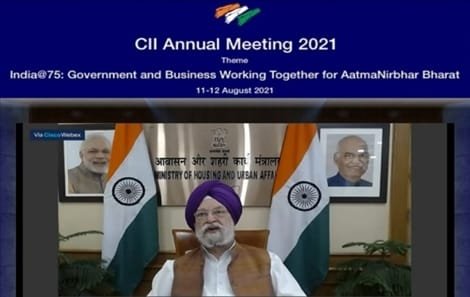Bajaj sees 600m Indians living in urban spaces by 2030
Further investments and incentives are needed to set up Sewage Treatment Plants and achieve 100% solid waste treatment in India, Hardeep Singh Puri, Minister of Housing and Urban Affairs has told one of India’s biggest meetings of the industry community.
“The systems of treatment of solid waste are still insufficient in India, with nearly 76%, Puri told the session on “Sustainable Urbanization” of the CII Annual Meeting 2021 held 11-12.
Most of the government programmes hold a strong component of the Public-Private-Partnership model. “With a historical perspective, we can look at the issues in urbanization in terms of continuity and change,” he underlined.
Elaborating, The Pradhan Mantri Awas Yojna is using four verticals, in-situ slum rehabilitation; credit linked subsidy scheme; beneficiary led construction scheme and Affordable Housing in partnership. There is a current demand of nearly 1.12 crore residential units which has been saturated as 52-53 lakh beneficiaries have already moved into the residences and nearly 82 lakh houses are under construction.
“We are also using latest technology in implementing these targets with 6 lighthouse projects as part of the Global Housing Technology Challenge-India that are intended to construct over 1000 residential units in less than a year,” he informed the meeting.
The Smart Cities Mission works on an inclusive and sustainable pattern wherein 76 cities of the 100 have urban centers and the rest are intended to be completed with the desired timelines despite the pandemic.
“We intend to take such schemes forward with Rs.145,000 crores allocated for the follow up of the Swachh Bharat Mission. 724-km of the metro is operational and 1,076kms is under construction. Metro light and Neo Metro are also to be added as urban mobility is central to the vision of sustainable urbanisation.”
The Pradhan Mantri Ujjwala Yojana has reached 30 crore gas connections in the country as compared to 14 crore in 2014. Currently, India has 18,000-km of gas pipeline and is expected to reach 32,000-km in the coming years.
Sanjiv Bajaj, CII President Designate, added that nearly 40% of the population, or approximately 600 million people, would live in urban spaces by 2030.
“As we know that urban centers are magnets and drivers of economic activity and employment generation, and we need more such magnets to enable future opportunities for the youth,” said Bajaj. #tenders #investment #projects #technology #infrastructure /fiinews.com









